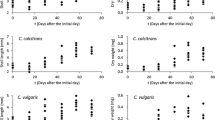Abstract
A dual-labelling radioisotope technique has enabled the relative assimilation efficiencies of an essential (Zn) and a non-essential trace metal (Cd) to be determined in an ecological series of talitrid amphipods from low-shore to fully terrestrial habitats. All species exhibited high assimilation efficiencies for zinc and cadmium (within the range 66.7–96.4%). Interspecific differences in assimilation rates showed no trend with increasing terrestriality of the habitat. Elevated dietary zinc concentrations failed to enhance zinc assimilation efficiency. Incorporation of antibiotics into the diet to eliminate gut microflora did not affect zinc assimilation efficiencies. The implications of having high trace-metal assimilation efficiencies are discussed in terms of land invasion by talitrids.
Similar content being viewed by others
References
Beeby A (1978) Interactions of lead and calcium uptake by the woodlouse Porcellio scaber (Isopoda: Porcellionidae) Oecologia 32:255–262
Bergkvist B, Folkeson L, Berggren D (1989) Fluxes of Cu, Zn, Pb, Cd, Cr and Ni in temperate forest ecosystems. Water, Air, Soil Pollut 47:217–286
Bignell DE (1984) The arthropod gut as an environment for microorganisms. In: Anderson JM, Rayner DM, Walton D (eds) Invertebrate-microbial Interactions (British Mycological Society Symposium No. 6). Cambridge University Press, Cambridge, pp 205–227
Black WAP, Mitchell RL (1952) Trace elements in the common brown algae and seawater. J Mar Biol Assoc UK 30:757–584
Calow P, Fletcher CR (1972) A new technique involving 14C and 53Cr for estimating the assimilation of efficiencies of aquatic primary consumers. Oecologia 9:155–170
Carefoot TH (1984) Studies on the nutrition of the supralittoral isopod Ligia pallasii using chemically defined artificial diets: Assessment of vitamin, carbohydrate, fatty acid, cholesterol and mineral requirements. Comp Biochem Physiol 79A:655–665
Dallinger R, Wieser W (1977) The flow of copper through a terrestrial food chain. In: copper and nutrition in isopods. Oecologia 30:253–264
Debry JM, Lebrun P (1979) Effets d'un enrichissement en CuSO4 sur le bilan alimentaire de Oniscus asellus (Isopoda). Rev Ecol Biol Sol 16:113–124
Hunt OD (1925) On the amphipod genus Talitrus with a description of a new species from the Scilly Isles, T. dorrieni n. sp. J Mar Biol Assoc UK 13:854–869
Icely JD, Nott JA (1984) On the morphology and fine structure of the alimentary canal of Corophium volutator. Philos Trans R Soc London 306:49–78
Martin MH, Coughtrey PJ, Young EW (1976) Observations on the availability of lead, zinc, cadmium and copper in woodland litter and the uptake of lead, zinc and cadmium by the woodlouse, Oniscus asellus. Chemosphere 5:313–318
Moore PG, Francis CH (1985) Some observations on food and feeding of the supralittoral beach-hopper Orchestia gammarellus (Pallas) (Crustacea: Amphipoda). Ophelia 24:183–197
Moore PG, Rainbow PS (1987) Copper and zinc in an ecological series of talitroidean Amphipoda (Crustacea). Oecologia 73:120–126
Spicer JI, Moore PG, Taylor AC (1987) The physiological ecology of land invasion by the Talitridae (Crustacea: Amphipoda). Proc R Soc London Ser B 232:95–124
Watkins BM, Simkiss K (1990) Interactions between soil bacteria and the molluscan alimentary tract. J Mollusc Stud 56:267–274
Weeks JM (1993) Effects of copper and zinc concentrations on feeding rates of two species of talitrid amphipods (Crustacea). Bull Environ Contam Toxicol 50:883–890
Weeks JM, Rainbow PS (1990) A dual-labelling technique to measure the relative assimilation efficiencies of invertebrates taking up trace metals from food. Funct Ecol 4:711–717
Wieser W (1967) Conquering terra firma: the copper problem from the isopod's point of view. Helgoländer Wiss Meeresunter 15:282–293
Author information
Authors and Affiliations
Rights and permissions
About this article
Cite this article
Weeks, J.M., Rainbow, P.S. Interspecific comparisons of relative assimilation efficiencies for zinc and cadmium in an ecological series of talitrid amphipods (Crustacea). Oecologia 97, 228–235 (1994). https://doi.org/10.1007/BF00323154
Received:
Accepted:
Issue Date:
DOI: https://doi.org/10.1007/BF00323154




